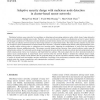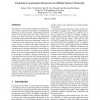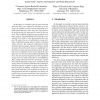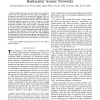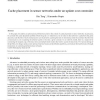COMCOM
2007
13 years 11 months ago
2007
Distributed wireless sensor networks have problems on detecting and preventing malicious nodes, which always bring destructive threats and compromise multiple sensor nodes. Theref...
WINET
2002
13 years 11 months ago
2002
Wireless ad-hoc sensor networks have the potential to provide the missing interface between the physical world and the Internet, thus impacting a large number of users. This conne...
WINET
2002
13 years 11 months ago
2002
As sensor networks edge closer towards wide-spread deployment, security issues become a central concern. So far, much research has focused on making sensor networks feasible and u...
CORR
2004
Springer
13 years 11 months ago
2004
Springer
The ability of a sensor node to determine its physical location within a network (Localization) is of fundamental importance in sensor networks. Interpretating data from sensors i...
CORR
2004
Springer
13 years 11 months ago
2004
Springer
In this paper, we consider a class of sensor networks where the data is not required in real-time by an observer; for example, a sensor network monitoring a scientific phenomenon ...
COMPUTER
2004
13 years 11 months ago
2004
Environmental Sensor Networks (ESNs) facilitate the study of fundamental processes and the development of hazard response systems. They have evolved from passive logging systems t...
CCR
2004
13 years 11 months ago
2004
Wireless sensor networks have attracted attention from a diverse set of researchers, due to the unique combination of distributed, resource and data processing constraints. Howeve...
TWC
2008
13 years 11 months ago
2008
Backscatter radio is proposed for sensor networks. In that way, the transmitter for each sensor is simplified to a transistor connected to an antenna and therefore, the cost for ea...
TWC
2008
13 years 11 months ago
2008
Symmetric key agreement is significant to security provisioning in sensor networks with resource limitations. A number of pairwise key pre-distribution protocols have been proposed...
JDA
2007
13 years 11 months ago
2007
In this paper, we address an optimization problem that arises in the context of cache placement in sensor networks. In particular, we consider the cache placement problem where th...
